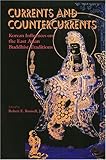Currents and Countercurrents : Korean Influences on the East Asian Buddhist Traditions / ed. by Robert E. Buswell.
Material type: TextPublisher: Honolulu : University of Hawaii Press, [2005]Copyright date: ©2005Description: 1 online resource (304 p.)Content type:
TextPublisher: Honolulu : University of Hawaii Press, [2005]Copyright date: ©2005Description: 1 online resource (304 p.)Content type: - 9780824827625
- 9780824874490
- 294.3/09519 22
- BQ658
- online - DeGruyter
- Issued also in print.
| Item type | Current library | Call number | URL | Status | Notes | Barcode | |
|---|---|---|---|---|---|---|---|
 eBook
eBook
|
Biblioteca "Angelicum" Pont. Univ. S.Tommaso d'Aquino Nuvola online | online - DeGruyter (Browse shelf(Opens below)) | Online access | Not for loan (Accesso limitato) | Accesso per gli utenti autorizzati / Access for authorized users | (dgr)9780824874490 |
Frontmatter -- Contents -- Acknowledgments -- Introduction -- CHAPTER 1. Paekche and the Incipiency of Buddhism in Japan -- CHAPTER 2. Kyŏvnghŭvng in Shinran's Pure Land Thought -- CHAPTER 3. Korea as a Source for the Regeneration of Chinese Buddhism -- CHAPTER 4. Ch'an Master Musang -- CHAPTER 5. Wov nch'uv k's Place in the East Asian Buddhist Tradition -- CHAPTER 6. The Korean Impact on T'ien-t'ai Buddhism in China -- CHAPTER 7. Ŭich'ŏn's Pilgrimage and the Rising Prominence of the Korean Monastery in Hang-chou during the Sung and Yu an Periods -- About the Contributors -- Index
restricted access online access with authorization star
http://purl.org/coar/access_right/c_16ec
Soon after the inception of Buddhism in the sixth or fifth century B.C.E., the Buddha ordered his small band of monks to wander forth for the welfare and weal of the many, a command that initiated one of the greatest missionary movements in world religious history. But this account of a monolithic missionary movement spreading outward from the Buddhist homeland of India across the Asian continent is just one part of the story. The case of East Asian Buddhism suggests another tale, one in which the dominant eastward current of diffusion creates important eddies, or countercurrents, of influence that redound back toward the center. These countercurrents have had significant, even profound, impact on neighboring traditions. In East Asia perhaps the most important countercurrent of influence came from Korea, the focus of this volume. Chapters examine the role played by the Paekche kingdom in introducing Buddhist material culture (especially monastic architecture) to Japan and the impact of Korean scholiasts on the creation of several distinctive features that eventually came to characterize Japanese Pure Land Buddhism. The lives and intellectual importance of the monks Sungnang (fl. ca. 490) and Wonch'uk (613-696) are reassessed, bringing to light their role in the development of early intellectual schools within Chinese Buddhism. Later chapters discuss the influential teachings of the semi-legendary master Musang (684-762), the patriarch of two of the earliest schools of Ch'an; the work of a dozen or so Korean monks active in the Chinese T'ient'ai tradition; and the Huiyin monastery.
Issued also in print.
Mode of access: Internet via World Wide Web.
In English.
Description based on online resource; title from PDF title page (publisher's Web site, viewed 02. Mrz 2022)


